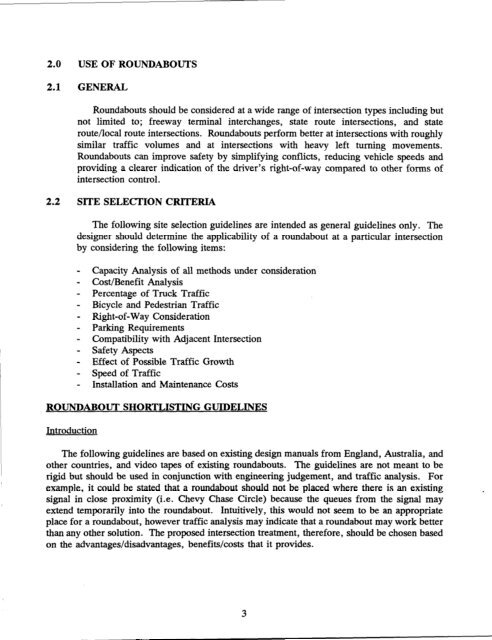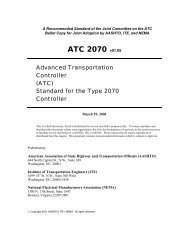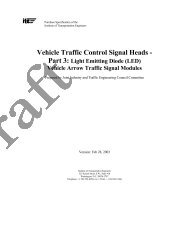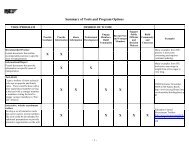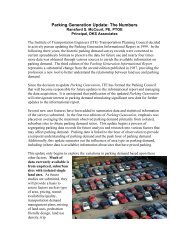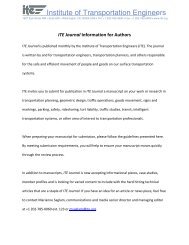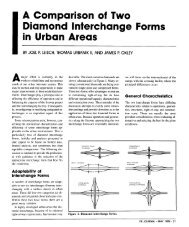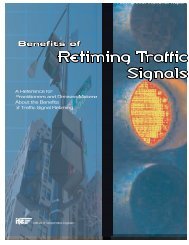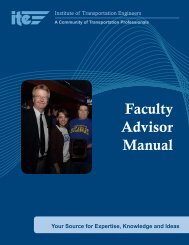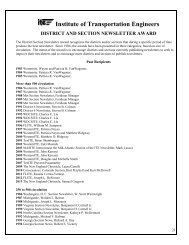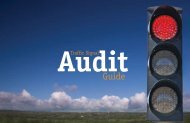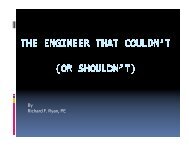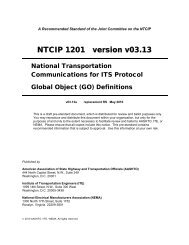roundabout ~' ~ design guidelines - Institute of Transportation ...
roundabout ~' ~ design guidelines - Institute of Transportation ...
roundabout ~' ~ design guidelines - Institute of Transportation ...
Create successful ePaper yourself
Turn your PDF publications into a flip-book with our unique Google optimized e-Paper software.
2.0 USE OF ROUNDABOUTS<br />
2.1 GENERAL<br />
Roundabouts should be considered at a wide range <strong>of</strong> intersection types including but<br />
not limited to; freeway terminal interchanges, state route intersections, and state<br />
route/local route intersections. Roundabouts perform better at intersections with roughly<br />
similar traffic volumes and at intersections with heavy left turning movements.<br />
Roundabouts can improve safety by simplifying conflicts, reducing vehicle speeds and<br />
providing a clearer indication <strong>of</strong> the driver’s right-<strong>of</strong>-way compared to other forms <strong>of</strong><br />
intersection control.<br />
2.2 SITE SELECTION CRITERIA<br />
The following site selection <strong>guidelines</strong> are intended as general <strong>guidelines</strong> only. The<br />
<strong>design</strong>er should determine the applicability <strong>of</strong> a <strong>roundabout</strong> at a particular intersection<br />
by considering the following items:<br />
- Capacity Analysis <strong>of</strong> all methods under consideration<br />
- Cost/Benefit Analysis<br />
- Percentage <strong>of</strong> Truck Traffic<br />
- Bicycle and Pedestrian Traffic<br />
- Right-<strong>of</strong>-Way Consideration<br />
- Parking Requirements<br />
- Compatibility with Adjacent Intersection<br />
- Safety Aspects<br />
- Effect <strong>of</strong> Possible Traffic Growth<br />
- Speed <strong>of</strong> Traffic<br />
- Installation and Maintenance Costs<br />
ROUNDABOUT SHORTLISTING GUIDELINES<br />
Introduction<br />
The following <strong>guidelines</strong> are based on existing <strong>design</strong> manuals from England, Australia, and<br />
other countries, and video tapes <strong>of</strong> existing <strong>roundabout</strong>s. The <strong>guidelines</strong> are not meant to be<br />
rigid but should be used in conjunction with engineering judgement, and traffic analysis. For<br />
example, it could be stated that a <strong>roundabout</strong> should not be placed where there is an existing<br />
signal in close proximity (i.e. Chevy Chase Circle) because the queues from the signal may<br />
extend temporarily into the <strong>roundabout</strong>. Intuitively, this would not seem to be an appropriate<br />
place for a <strong>roundabout</strong>, however traffic analysis may indicate that a <strong>roundabout</strong> may work better<br />
than any other solution. The proposed intersection treatment, therefore, should be chosen based<br />
on the advantages/8disadvantages, benefits/costs that it provides.<br />
.<br />
3


